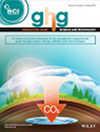Xiangbo Zou, Kai Xiong, Wei Zhao, Yafang Li, Dequn Ma, Chuangting Chen, Zhenwei Yi, Tao Wang
求助PDF
{"title":"工业固体废弃物无水泥骨料:优化制备及环境影响评价","authors":"Xiangbo Zou, Kai Xiong, Wei Zhao, Yafang Li, Dequn Ma, Chuangting Chen, Zhenwei Yi, Tao Wang","doi":"10.1002/ghg.2336","DOIUrl":null,"url":null,"abstract":"<div>\n \n <p>To address the issues of high density and low strength in traditional non-fired lightweight aggregates, using CO<sub>2</sub> mineralization curing can effectively enhance product performance and synergistically utilize industrial solid waste and CO<sub>2</sub>. CO<sub>2</sub> mineralization curing significantly improves the cylindrical compressive strength of lightweight aggregates (6.8 MPa), reduces the water absorption rate (6.83%), and achieves a suitable bulk density (896 kg/m<sup>3</sup>). By analyzing the carbonation rate of different particle sizes through gas–solid reaction kinetics, it was found that the rate curve of mineralization curing for lightweight aggregate samples better fits the three-dimensional diffusion model, with smaller particles exhibiting a higher carbonation rate. Microscopic characterization analysis revealed that the primary mineralization product is calcium carbonate, which is present in the form of calcite. Higher curing temperatures and prolonged durations may result in decalcification within the lightweight aggregates. Moreover, the calcium carbonate particles produced during the carbonation process can cause expansion of the internal structure of the lightweight aggregates, leading to a decline in the mechanical properties of the product. The life cycle carbon emissions for each ton of steam-cured lightweight aggregate are 105.821 kg, whereas the life cycle carbon emissions for CO<sub>2</sub> mineralized lightweight aggregates are only −1.879 kg, making this method beneficial for clean production and solving significant problems in actual production. © 2025 Society of Chemical Industry and John Wiley & Sons, Ltd.</p>\n </div>","PeriodicalId":12796,"journal":{"name":"Greenhouse Gases: Science and Technology","volume":"15 3","pages":"305-318"},"PeriodicalIF":2.8000,"publicationDate":"2025-04-03","publicationTypes":"Journal Article","fieldsOfStudy":null,"isOpenAccess":false,"openAccessPdf":"","citationCount":"0","resultStr":"{\"title\":\"Cementless Aggregate From Industrial Solid Wastes: Optimization Preparation and Environmental Impact Assessment\",\"authors\":\"Xiangbo Zou, Kai Xiong, Wei Zhao, Yafang Li, Dequn Ma, Chuangting Chen, Zhenwei Yi, Tao Wang\",\"doi\":\"10.1002/ghg.2336\",\"DOIUrl\":null,\"url\":null,\"abstract\":\"<div>\\n \\n <p>To address the issues of high density and low strength in traditional non-fired lightweight aggregates, using CO<sub>2</sub> mineralization curing can effectively enhance product performance and synergistically utilize industrial solid waste and CO<sub>2</sub>. CO<sub>2</sub> mineralization curing significantly improves the cylindrical compressive strength of lightweight aggregates (6.8 MPa), reduces the water absorption rate (6.83%), and achieves a suitable bulk density (896 kg/m<sup>3</sup>). By analyzing the carbonation rate of different particle sizes through gas–solid reaction kinetics, it was found that the rate curve of mineralization curing for lightweight aggregate samples better fits the three-dimensional diffusion model, with smaller particles exhibiting a higher carbonation rate. Microscopic characterization analysis revealed that the primary mineralization product is calcium carbonate, which is present in the form of calcite. Higher curing temperatures and prolonged durations may result in decalcification within the lightweight aggregates. Moreover, the calcium carbonate particles produced during the carbonation process can cause expansion of the internal structure of the lightweight aggregates, leading to a decline in the mechanical properties of the product. The life cycle carbon emissions for each ton of steam-cured lightweight aggregate are 105.821 kg, whereas the life cycle carbon emissions for CO<sub>2</sub> mineralized lightweight aggregates are only −1.879 kg, making this method beneficial for clean production and solving significant problems in actual production. © 2025 Society of Chemical Industry and John Wiley & Sons, Ltd.</p>\\n </div>\",\"PeriodicalId\":12796,\"journal\":{\"name\":\"Greenhouse Gases: Science and Technology\",\"volume\":\"15 3\",\"pages\":\"305-318\"},\"PeriodicalIF\":2.8000,\"publicationDate\":\"2025-04-03\",\"publicationTypes\":\"Journal Article\",\"fieldsOfStudy\":null,\"isOpenAccess\":false,\"openAccessPdf\":\"\",\"citationCount\":\"0\",\"resultStr\":null,\"platform\":\"Semanticscholar\",\"paperid\":null,\"PeriodicalName\":\"Greenhouse Gases: Science and Technology\",\"FirstCategoryId\":\"93\",\"ListUrlMain\":\"https://scijournals.onlinelibrary.wiley.com/doi/10.1002/ghg.2336\",\"RegionNum\":4,\"RegionCategory\":\"环境科学与生态学\",\"ArticlePicture\":[],\"TitleCN\":null,\"AbstractTextCN\":null,\"PMCID\":null,\"EPubDate\":\"\",\"PubModel\":\"\",\"JCR\":\"Q3\",\"JCRName\":\"ENERGY & FUELS\",\"Score\":null,\"Total\":0}","platform":"Semanticscholar","paperid":null,"PeriodicalName":"Greenhouse Gases: Science and Technology","FirstCategoryId":"93","ListUrlMain":"https://scijournals.onlinelibrary.wiley.com/doi/10.1002/ghg.2336","RegionNum":4,"RegionCategory":"环境科学与生态学","ArticlePicture":[],"TitleCN":null,"AbstractTextCN":null,"PMCID":null,"EPubDate":"","PubModel":"","JCR":"Q3","JCRName":"ENERGY & FUELS","Score":null,"Total":0}
引用次数: 0
引用
批量引用





 求助内容:
求助内容: 应助结果提醒方式:
应助结果提醒方式:


